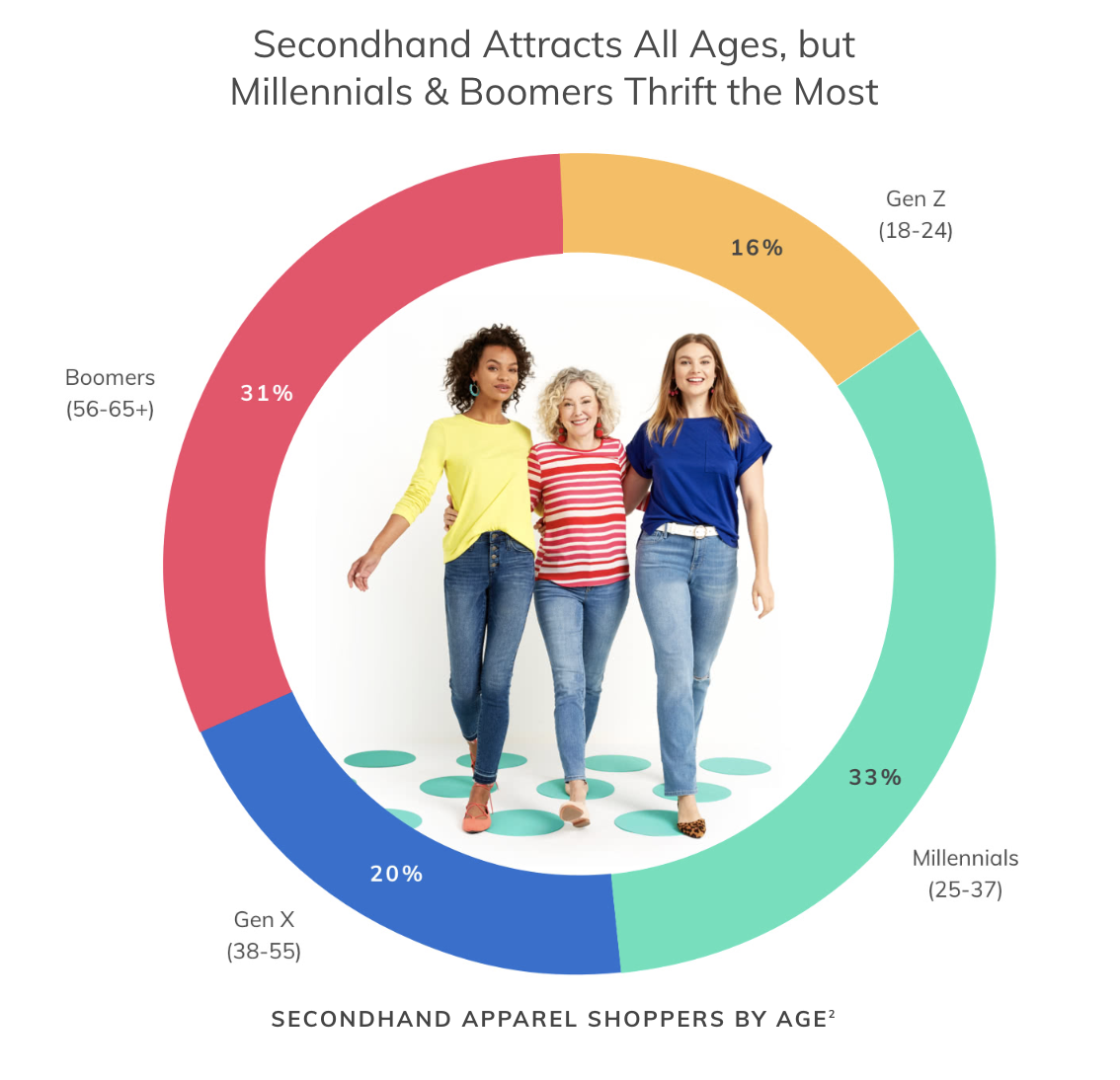Society is at an inflection point of consumerism—we still want new things, but our definition of new is changing. A wave of secondhand fashion, furniture and beauty is swelling, creating a new ecosystem for consumers and brands alike.
In a matter of five years, the secondhand apparel market (which includes resale, thrift and donations) is poised to double in growth to $51B, which is nearly a 5x growth since 2012.
Resale has grown 21x faster than the retail apparel market over the past three years and a decade from now, if all goes as planned, secondhand apparel will be larger than fast fashion.
What is secondhand exactly? Essentially anything that has been owned before and now is in a second pair of hands. Used, vintage, antique, thrift, preowned and "preloved" are all considered secondhand (although they definitely have different connotations). And business terms like recommerce, resale and upcycling (side note: this is more about using something old for a different purpose, vs. the same purpose, but it still sort of counts) are used somewhat interchangeably.
The main players in this space are Poshmark (50MM users), thredUP (20K daily users), The RealReal (400K users), Depop (13MM users, started in the UK), Vestiaire Collective (8MM users, started in Paris), and Tradesy (1MM users). And of course, eBay and Craigslist count too.
They've smartly developed various ways to make it easy and fun for the consumer. ThredUp does all the heavy lifting for you—they'll send you a "clean out kit" with pre-paid postage to fill up and return, and then will sort, list and sell your clothes for you in return for cash or credit.
The RealReal is very meticulous with their authentication of luxury items. Poshmark and Depop look more like social media platforms, which have spawned their own set of influencers.
This isn't just a digital revolution, though, it's having an offline effect as well. Brick and mortar retailers like Nordstrom's, Macy's and JC Penney have not only created curated sections in their stores for secondhand clothing but also have developed a virtuous cycle by allowing shoppers to drop off old items and get store credit towards new items.
In looking at Google Trends, you can see that search interest growth has increased for all of the following stores near me (second hand, consignment, vintage, antique) in the top chart. As you can see from the bottom chart (where "thrift store near me" is added to the mix), people are way more interested in thrift stores than any of the others.
So who is this thrifty group embracing secondhand style?
According to thredUP's CEO, James Reinhart, "The resale customer is no longer somebody else’s customer, they are everybody’s customer. Mass market or luxury, if people can find a high-quality product for much less, they’ll choose used."
64% of women have bought secondhand or are now open to buying it, up from 45% in 2016. Secondhand shoppers run the gamut from luxury buyers (Gucci) to department store shoppers (Nordstroms) to value chain choppers (Walmart, Target, Old Navy).
As you can see from the chart below, all age groups are involved, with Millennials and Boomers leading the charge.
Don't worry guys, you can get in on this trend too. Poshmark has men's clothing and Grailed, a secondhand marketplace dedicated solely to dudes, has been gaining tons of traction with 3.7MM users. They've gotten so cool that brands are launching new items exclusively with them...the irony.
What has contributed to this shift to secondhand? The negative layers of secondhand clothing stereotypes are shedding and metamorphosing into style pizzazz.
In an interview with my good friend Elizabeth Cook, founder of Domino Media Group and self-proclaimed estate sale junkie (truly, follow her for killer auction tips and vintage finds galore), she says the main reason is that "it is no longer a taboo to talk about buying second hand and it is really the way to purchase luxury items at attainable price points. It is also way more stylish to have an antique (which you have to buy second hand) vs. a new rendition in your home or to wear a killer vintage dress opposed to one everyone has access to today!"
What are some other factors?
The state of luxury is changing—it's getting more expensive but the people still want it. McKinsey and Business of Fashion's 2019 State of Fashion white paper reports that "prices of fine watches and jewelry have nearly doubled since 2005" which is conversely driving the rise in secondhand. Now, with a bit of online sleuthing, you can still snag that Chloe you've been eyeing at a much more affordable price.
Elizabeth foresees "a slowing of luxury sales as a result of the growing resale momentum" and predicts that "publicly held fashion and furniture companies will shift to a portion of sales funneled through short-term rental programs over the next decade."
No surprise, social media also plays a role. One in seven consider it "a fashion faux-pas to be photographed in an outfit twice" (my guess is that this number is actually way higher and people just don't want to admit it!).
And finally, sustainability. I will do a deep dive on this later in the year, but the fashion industry is one of the worst offenders in regards to pollution and waste. JWT Intelligence predicts that as "awareness of environmental damage rise, shoppers are consciously stepping back from the ledge of excess consumer culture", a trend they've coined anti-excess consumerism.
Shopping secondhand provides an outlet for retail therapy without perpetuating the negative impact that new clothing production has on the globe. Luckily, the average number of items in our closet is starting to decrease.
What trends do you have to look forward to in this space? Swishing, regifting and grandmillennials. These are currently micro trends, but my guess is they'll grow into macro trends soon enough.
Swishing is a clothing-swap event where you bring your own items and leave with someone elses. It started in the UK, and bets are it will hop over the pond.
Regifting, or giving secondhand items as gifts, is now in vogue. According to Accenture, "nearly half (48%) of respondents said they would consider giving second-hand clothing as gifts, and even more (56%) said they would welcome gifts of this kind for themselves."
Grandmillennial style or "granny chic" is a new ode to the old (thank Elizabeth for this one). House Beautiful describes it as "devotees who love wicker, chintz and needlepoint—but don't call them stuffy." If you're wondering how grandmillennial you are, make sure to take their quiz.
What other industries are being affected?
You couldn't talk about the resale market without mentioning sneakers—Business Insider reports that it is "estimated to be a $2 billion market, and is projected to triple over the next several years, reaching more than $6 billion by 2025." Apps like Goat and StockX are leading the way, with some rare kicks finding a new set of feet for only $8K(!).
The furniture market is heating up too. Poshmark recently added a furniture section to their site and online auction sites are having a heyday. Going, going, gone!
And finally, makeup. I'm as shocked as you are that people would be willing to buy preowned AND pre-used makeup, but they do (especially for the buzzy specialty drops that send beauty lovers into a tizzy). Secondhand beauty app Glambot professionally sanitizes each product before reselling it.
What does this all mean? What's new gets old, and what's old is new again. As the secondhand market continues to grow, ask yourself these questions: Are there ways to make your products last longer? Are there products your brand should bring back? Are there used marketplaces you can make money from? Consider what your secondhand strategy is in addition to your firsthand sales.





